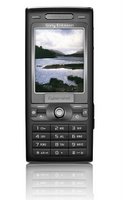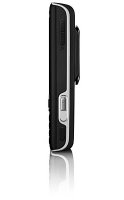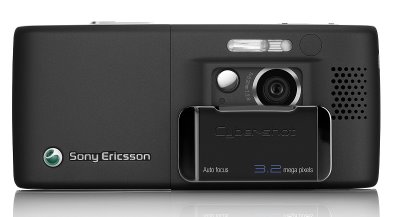 The K790 is one heck of a cell phone. Inside the stylish and sleek design, you'll find a wealth of well-designed and high-performing features. And as Sony Ericsson's first Cyber Shot-branded phone, the 3.2-megapixel camera is top notch. There were a couple drawbacks here and there - it lacks world phone support, and the navigation controls took acclimation - but otherwise the K790 is a solid device all around. At present it's priced at $499.
The K790 is one heck of a cell phone. Inside the stylish and sleek design, you'll find a wealth of well-designed and high-performing features. And as Sony Ericsson's first Cyber Shot-branded phone, the 3.2-megapixel camera is top notch. There were a couple drawbacks here and there - it lacks world phone support, and the navigation controls took acclimation - but otherwise the K790 is a solid device all around. At present it's priced at $499.Design of Sony Ericsson K790
Like most of Sony Ericsson's cell phones, the K790 sports a simple candy bar form factor. Though it's almost perfectly rectangular, it still has a sleek and stylish design that's sure to catch attention. What's more, the black and gray color scheme accurately reflects the high-tech features inside. The K790 is far from compact (4.1 by 1.9 by 0.9 inches; 4.1 ounces); a solid construction and comfortable feel in the hands is a worthy trade-off. Just be advised it won't fit in smaller pockets.
Like many Sony Ericssons, the K790 has a brilliant 262,144-color display that richly captures whatever content it shows. At two inches diagonally, it takes almost half of the real estate on the phone's front face, while the 240x320 pixel resolution makes for eye-popping colors and sharp graphics and animation. You can change the brightness but not the font size. Below the display is the main navigation array, which is a throwback to the controls on the Sony Ericsson K700i. A five-way joystick doubles as a shortcut to four user-defined functions, while the two soft keys open the recent calls list and the main menu when the phone is in standby mode. You also get dedicated Back and Clear buttons, a key that launches the Web browser, and a nifty control that opens a submenu of user-defined shortcuts and a list of upcoming calendar events. Overall the navigation controls were tactile and easy to use, but they are squashed between the display and the keypad buttons. As a result, they take some acclimation due to their relatively small size.
Speaking of keypad buttons, we were pleased with those on the K790. While previous Sony Ericssons such as the W300i often slipped in the design of their keypad buttons, the K790's are a big improvement. Rectangular in shape, they're large enough for most hands, and since they're raised just above the surface of the phone, it was easy to dial by feel. They're brightly backlit as well, so dialing in dim situations was not a problem.
 A music player button and the Memory Stick Micro slot sit on the left spine, while the right spine holds a volume rocker and a camera shutter control. The most interesting feature is on the back of the handset, however. Just slide down the back cover to expose the camera lens and self-portrait mirror. Above is the large flash, which, believe us, is like no other flash we've seen on a camera phone (see Performance). When viewed from behind, the phone looks very much like a standalone camera; the camera shutter even shifts to the top of the phone when it's held horizontally. Completing the exterior is a small speaker next to the camera lens.
A music player button and the Memory Stick Micro slot sit on the left spine, while the right spine holds a volume rocker and a camera shutter control. The most interesting feature is on the back of the handset, however. Just slide down the back cover to expose the camera lens and self-portrait mirror. Above is the large flash, which, believe us, is like no other flash we've seen on a camera phone (see Performance). When viewed from behind, the phone looks very much like a standalone camera; the camera shutter even shifts to the top of the phone when it's held horizontally. Completing the exterior is a small speaker next to the camera lens. Features of Sony Ericsson K790
There's a lot to tell about the K790's innards, but we'll get the basics out of the way first. The phone book holds a respectable 1,000 contacts, with room in each entry for five phone numbers, Web and e-mail addresses, a work title and company name, work and home street addresses, a birth date, and notes (the SIM card holds an additional 250 names). You can organize contacts into groups and pair them with a photo for caller ID. You can pair contacts with a ring tone as well, but oddly only 16 72-chord polyphonic tones are included. Fortunately the K790 supports MP3 tones, and you can even use videos for caller ID as well. Other essential offerings include a vibrate mode, text and multimedia messaging, an alarm clock, a calendar, a task list, a timer, a stopwatch, a calculator, a notepad, and a voice memo recorder (space is limited by the available memory).
The K790 also comes with a wealth of business-friendly features that should please most worker bees. You'll find full Bluetooth for connecting to a wireless headset or sending files or your electronic business card to another Bluetooth device. And like with many other Sony Ericssons, you can use the phone as a modem and use the Bluetooth feature as a remote control to connect with other Bluetooth devices. Other high-end goodies include a speakerphone, an RSS newsreader, an infrared port, PC syncing for contacts and other files, USB cable support, e-mail, voice dialing, and a code memo for storing passwords and other secure information.

While Sony Ericsson's Walkman phones focus on music first and photography second, it's not surprising that the company's Cyber Shot phones do just the opposite. And as the K790 is the first Cyber Shot handset we've inspected closely, we can report that it rises to the challenge successfully. In short, the 3.2 megapixel K790 is the most advanced camera phone we've reviewed, surpassing the Nokia N80 and the Nokia N90 in features and in performance. It marks a very long leap in the direction of making camera phones truly functional devices rather than just a fun novelty. While previously we thought cell phones and MP3 players made more logical convergence devices, the K790 has caused us to rethink that theory.
The camera's feature list rivals that of many standalone shooters. You can take pictures in four resolutions, from VGA up to the full 3 meagpixels, and choose from two image-quality choices. Other standout features include a panorama mode; 16X digital zoom; a BestPic function for taking several photos in rapid succession; 15 fun frames; a self timer; six lighting settings, including beach/snow and twilight; four picture effects; a white balance control; spot metering; four shutter sounds; autofocus; and a macro setting. There's also an image stabilization feature, which effectively corrects the blurriness that plagues many camera phone pictures. The camcorder, which takes MPEG-4 clips with sound in one resolution (176x144), also comes with a generous feature selection. You can use the auto or macro focus setting, adjust the white balance, activate a night mode, choose from four video effects, or use spot metering. The remarkable Xenon flash is the most powerful light we've seen on a camera phone. It flooded our photos and videos with light even in dim situations. The default setting is auto, but you can turn it off completely or use a red-eye reduction mode.
Picture quality was very good, with bright colors, distinct object outlines, and sharp effects. The washed-out effect visible in many camera phone pictures was hard to find overall. Yet because the flash is so strong, it flooded photos with too much light in some situations. We advise using it at your discretion. And keep in mind that even though it's an excellent camera phone, we still wouldn't toss our standalone shooter just yet. Video quality was also satisfactory, but don't expect too much; clips were a bit grainy. Videos meant for multimedia messages are capped at two minutes; otherwise length is limited by the available memory. Creative types can use the Photo DJ to rotate the shot's orientation and use various editing options such as brightness and contrast adjustments, light balance settings, red-eye removal, color effects, and photo marking. There's also a Video DJ function with similar options.
When you're finished with your photos, you can save them to the phone's 64MB of shared internal memory. With such large photo files, however, space is likely to go fast, so we recommend investing in a Memory Stick Micro. Fortunately a user-friendly file manager lets you transfer images back and forth. To get pictures off your phone, you can send them wirelessly via Bluetooth or an e-mail or a multimedia message, upload quickly them to an online blog, or transfer them to a computer via a USB cable. The K790 also comes with an HP Print function for wirelessly printing photos, calendar entries, and contacts to a compatible HP printer. And in case the camera is too much for you, the phone comes with a handy Photo Mate feature, which describes the various camera settings in detail and gives tips on taking and sharing photos.
Music fans can get use out of the K790 as well. The phone comes with a digital music player similar to the player found on the Walkman phones but with a slightly different interface and functionality. Opening the player takes you directly to the main menu, where you can organize music by artist, track name, or playlist. Settings include album/song shuffle and loop, stereo widening, and an equalizer. Switching between the cell phone and the music player is seamless, as music automatically stops when you receive a call. Hang up, and your song picks up from the point you left off. There's an airplane mode that lets you listen to your tunes in flight with the cell phone turned off, and you can minimize the player while using other functions. There are stereo speakers on the back and the front of the phone as well, and we're thrilled that the phone supports a stereo Bluetooth profile.
Music capacity is limited by the available memory, so again buying a Memory Stick Micro is a good idea. Getting music on the phone is relatively easy. In addition to using the included USB cable, you can send tunes via Bluetooth or the infrared port. You also get an FM radio with 20 presets, though you must use it with a headset, which acts as an antenna. You can set it to automatically scan and program Radio Data System info from stations that digitally broadcast their names and call letters, and you can use the radio as an alarm clock.
You can personalize the K790 with a variety of themes, wallpaper, and screensavers. As always, you can purchase more options and ring tones from Sony Ericsson via the WAP 2.0 wireless Web browser. Alternatively, the phone comes with a Music DJ application for composing your own ring tones. Gamers can enjoy three Java (J2ME) titles: FotoQuest Fishing, Mini Golf: Castle, and WTA S.R. Tennis, with additional titles available for purchase. The 3D games were a treat to play on the K790's gorgeous display.
Performance of Sony Ericsson K790
We tested the triband (GSM 850/1800/1900; EDGE) Sony Ericsson K790 in San Francisco using Cingular service. Call quality was very good with nice clarity, little static, and no interference from other electronic devices. We also had no problem getting a signal, and though volume could be a bit louder on our end, it should be quite serviceable for most users. Callers reported similar conditions; they could tell we were using a cell phone, but they had few problems hearing or understanding us. Speakerphone quality was good as well. Just take note that the main speaker faces the back of the phone. We tried connecting to the Plantronics Explorer 320 Bluetooth headset, and though we encountered a tiny bit of static, it wasn't bothersome. And in any case, that could be due more to the headset than the phone.
For such a high-featured phone, however, we were miffed that the K790 does not offer quadband world phone support. On the upside, Web browsing was zippy, we had no problems sending files via Bluetooth, and music quality was good. We didn't detect a significant difference from Walkman-branded phones such as the W810i
The K790 has a rated talk time of seven hours and a promised standby time of 14 days. We got an impressive six hours and 40 minutes of talk time in our tests.

0 comments: